Abstract
A case control study of foal diarrhoea in the United Kingdom was carried out over a 3-year period. Clostridium perfringens was significantly associated with foal diarrhoea (Odds Ratio (OR) = 3.0), being isolated from 57% of 421 animals with diarrhoea but from only 27% of 223 healthy foals. Also, C. perfringens was significantly associated with fatal diarrhoea (OR = 4.5). About half of diarrhoea with a fatal outcome was attributable to this organism. The other pathogens significantly associated with diarrhoea were rotavirus (OR = 5.6), Cryptosporidium spp. (OR = 3.2) and the nematode Strongyloides westeri, which was significant only when present in large numbers (> 2000 eggs/g of faeces: OR = 6.1). Salmonella spp. (OR = 14.2) and Cryptosporidium spp. (OR = 3.0) were the only other pathogens associated with fatal illness. Overall, C. perfringens, rotavirus, and large numbers of Cryptosporidium spp. or S. westeri were isolated from 80% of foals with diarrhoea. Thermophilic Campylobacter spp., Yersinia enterocolitica, Escherichia coli and other parasites were not associated with diarrhoea. Carriage of C. perfringens, rotavirus and Cryptosporidium spp. was significantly greater in healthy foals in contact with cases of diarrhoea than in foals that were not in contact with diarrhoea (P < 0.05). There were no statistical interactions between any of the pathogens associated with diarrhoea although separate cases from one location often involved more than one pathogen.
Full text
PDF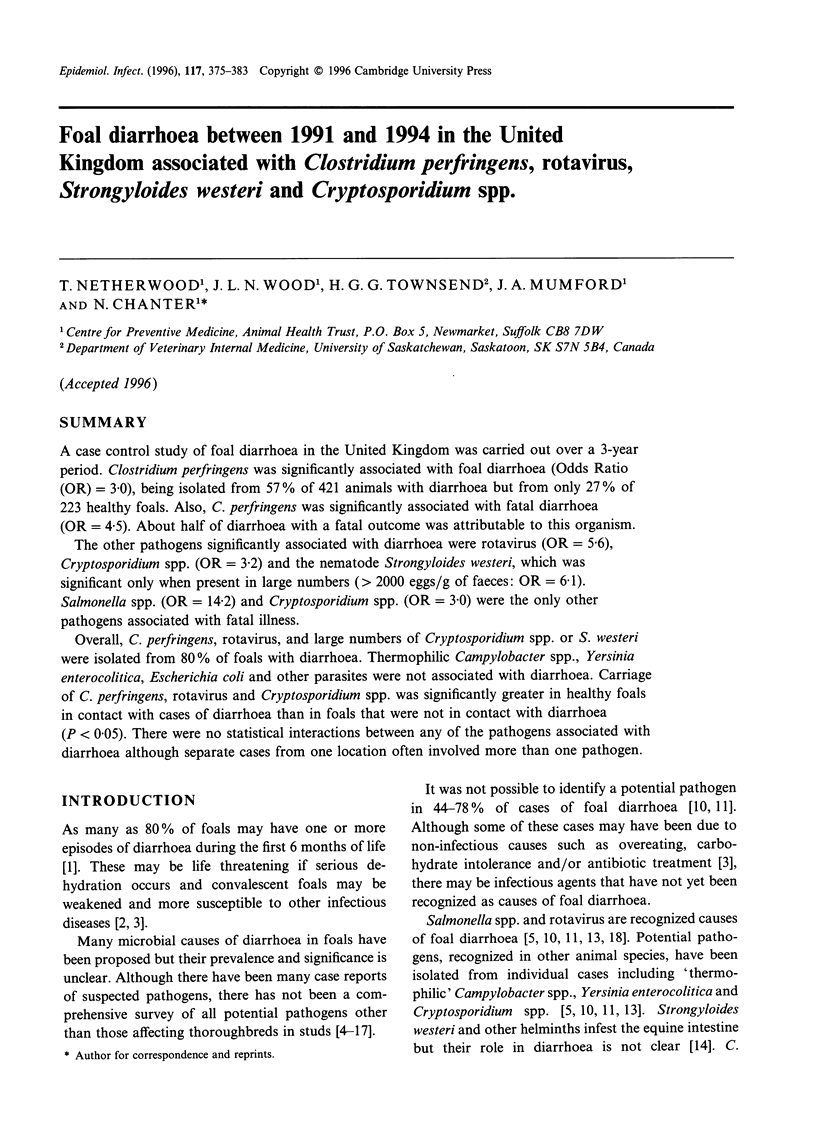
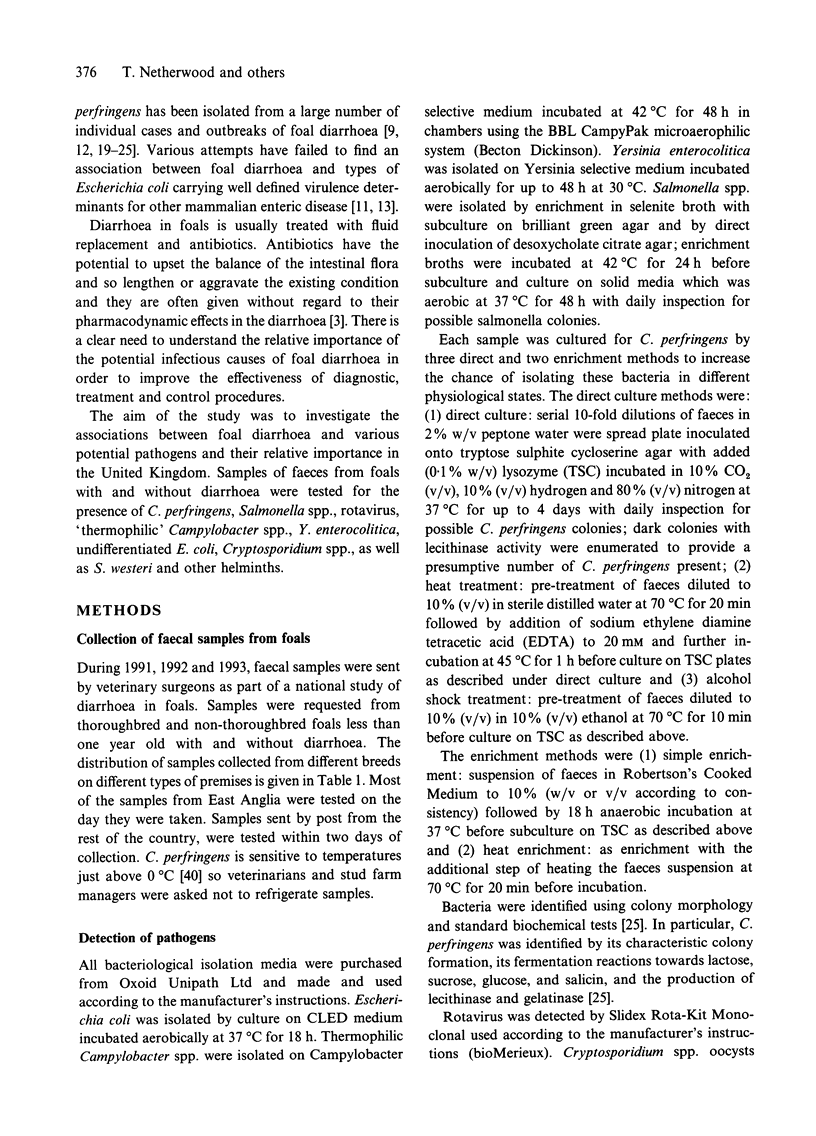
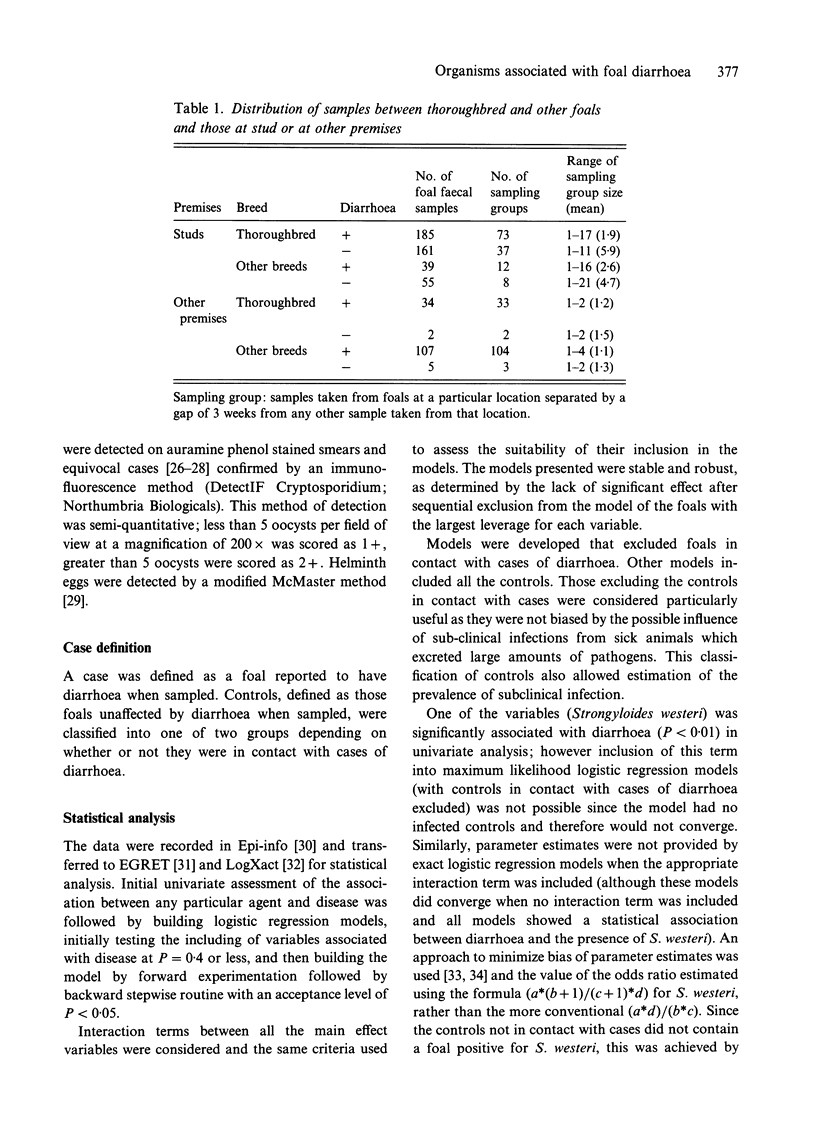
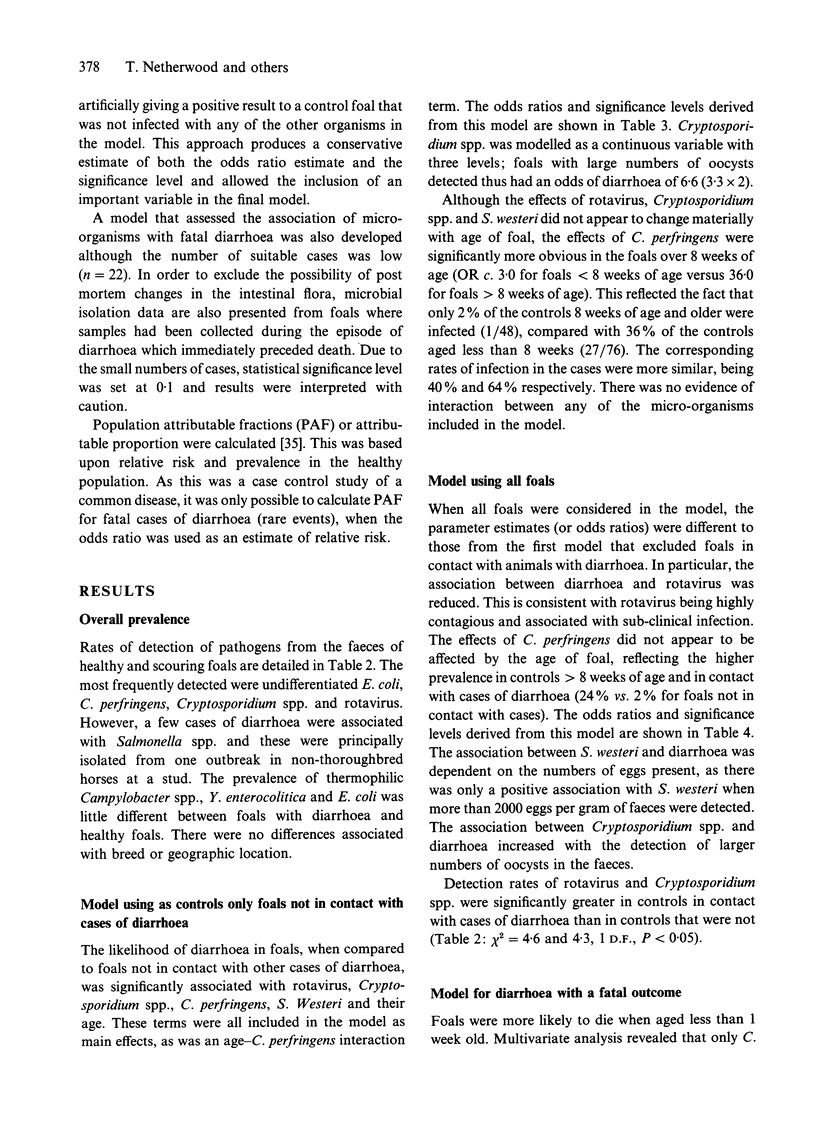
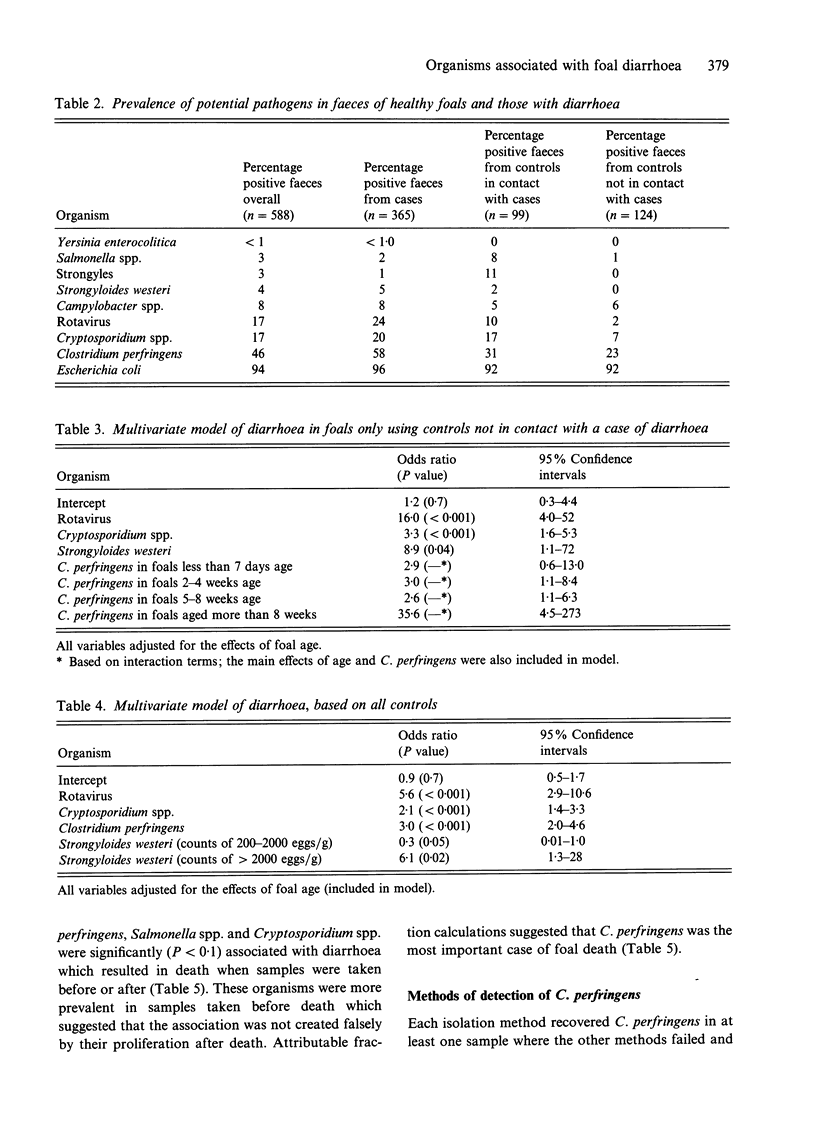
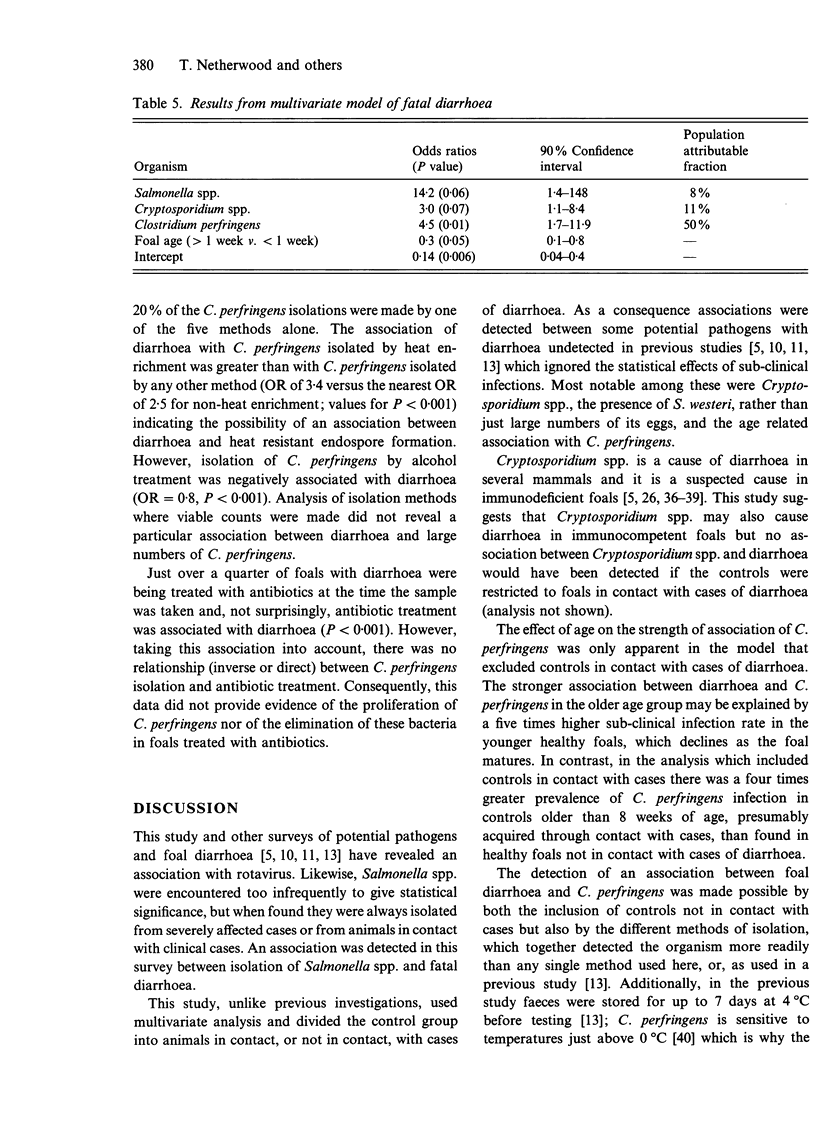
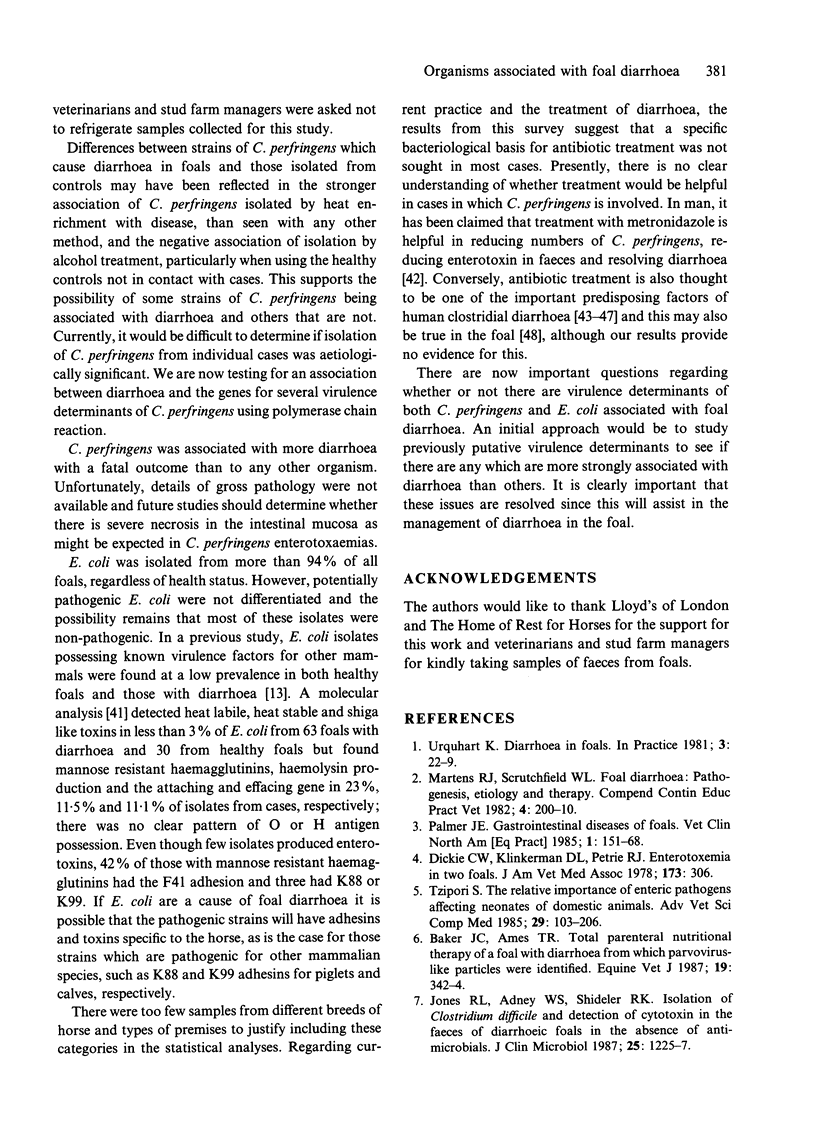
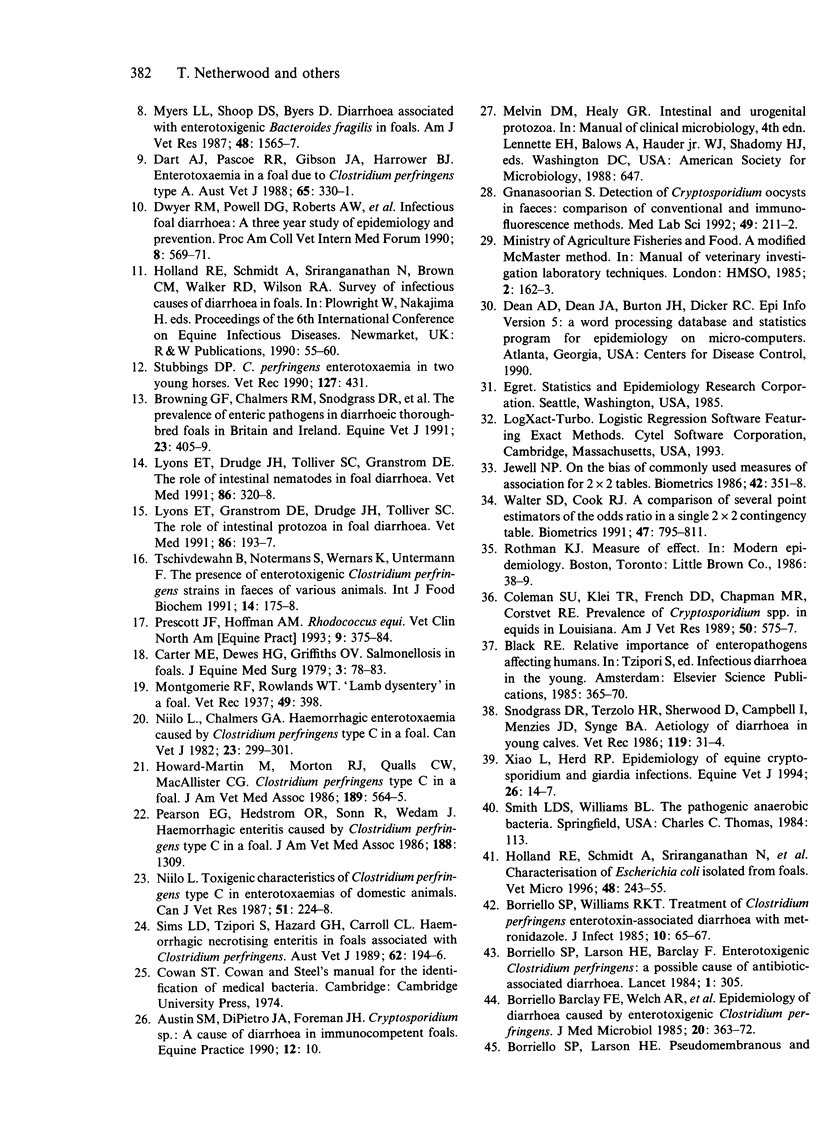
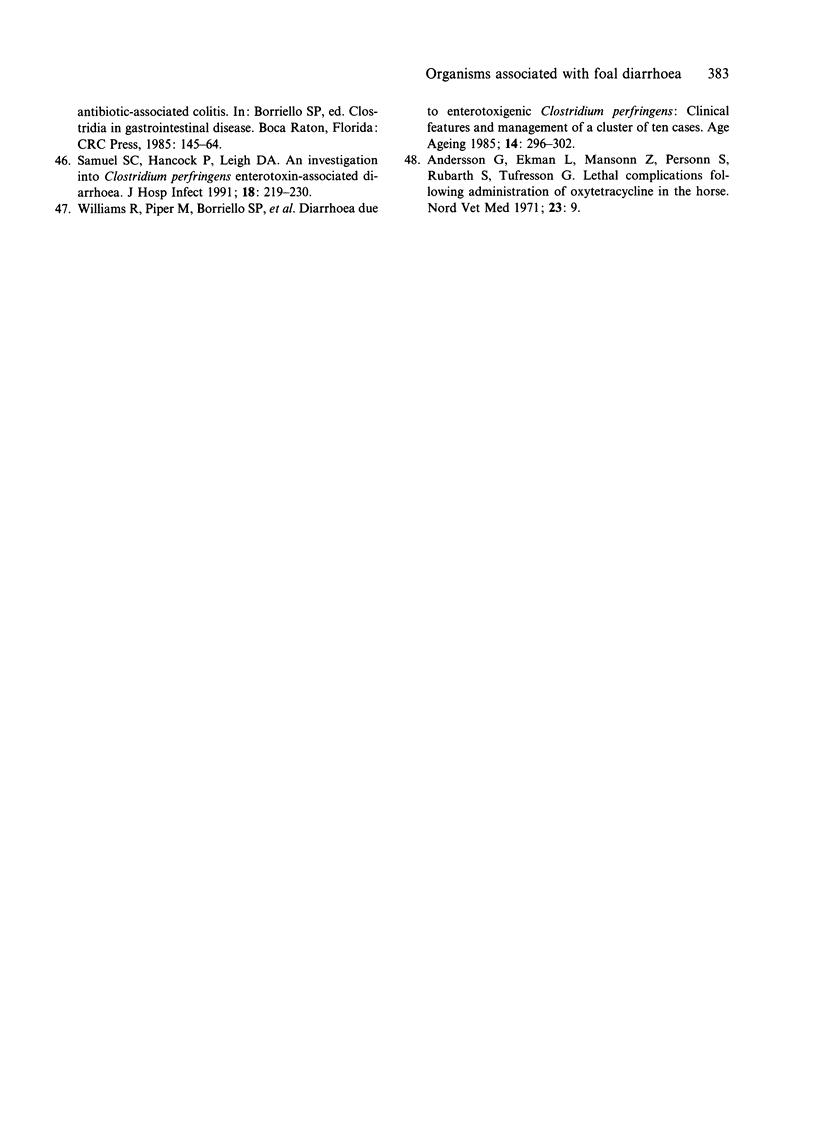
Selected References
These references are in PubMed. This may not be the complete list of references from this article.
- Andersson G., Ekman L., Månsson I., Persson S., Rubarth S., Tufvesson G. Lethal complications following administration of oxytetracycline in the horse. Nord Vet Med. 1971 Jan;23(1):9–22. [PubMed] [Google Scholar]
- Baker J. C., Ames T. R. Total parenteral nutritional therapy of a foal with diarrhoea from which parvovirus-like particles were identified. Equine Vet J. 1987 Jul;19(4):342–344. doi: 10.1111/j.2042-3306.1987.tb01429.x. [DOI] [PMC free article] [PubMed] [Google Scholar]
- Borriello S. P., Barclay F. E., Welch A. R., Stringer M. F., Watson G. N., Williams R. K., Seal D. V., Sullens K. Epidemiology of diarrhoea caused by enterotoxigenic Clostridium perfringens. J Med Microbiol. 1985 Dec;20(3):363–372. doi: 10.1099/00222615-20-3-363. [DOI] [PubMed] [Google Scholar]
- Borriello S. P., Larson H. E., Welch A. R., Barclay F., Stringer M. F., Bartholomew B. A. Enterotoxigenic Clostridium perfringens: a possible cause of antibiotic-associated diarrhoea. Lancet. 1984 Feb 11;1(8372):305–307. doi: 10.1016/s0140-6736(84)90359-3. [DOI] [PubMed] [Google Scholar]
- Borriello S. P., Williams R. K. Treatment of Clostridium perfringens enterotoxin-associated diarrhoea with metronidazole. J Infect. 1985 Jan;10(1):65–67. doi: 10.1016/s0163-4453(85)80013-x. [DOI] [PubMed] [Google Scholar]
- Browning G. F., Chalmers R. M., Snodgrass D. R., Batt R. M., Hart C. A., Ormarod S. E., Leadon D., Stoneham S. J., Rossdale P. D. The prevalence of enteric pathogens in diarrhoeic thoroughbred foals in Britain and Ireland. Equine Vet J. 1991 Nov;23(6):405–409. doi: 10.1111/j.2042-3306.1991.tb03751.x. [DOI] [PMC free article] [PubMed] [Google Scholar]
- Coleman S. U., Klei T. R., French D. D., Chapman M. R., Corstvet R. E. Prevalence of Cryptosporidium sp in equids in Louisiana. Am J Vet Res. 1989 Apr;50(4):575–577. [PubMed] [Google Scholar]
- Dart A. J., Pascoe R. R., Gibson J. A., Harrower B. J. Enterotoxaemia in a foal due to Clostridium perfringens type A. Aust Vet J. 1988 Oct;65(10):330–331. doi: 10.1111/j.1751-0813.1988.tb14521.x. [DOI] [PubMed] [Google Scholar]
- Dickie C. W., Klinkerman D. L., Petrie R. J. Enterotoxemia in two foals. J Am Vet Med Assoc. 1978 Aug 1;173(3):306–307. [PubMed] [Google Scholar]
- Holland R. E., Schmidt A., Sriranganathan N., Grimes S. D., Wilson R. A., Brown C. M., Walker R. D. Characterization of Escherichia coli isolated from foals. Vet Microbiol. 1996 Feb;48(3-4):243–255. doi: 10.1016/0378-1135(95)00162-x. [DOI] [PubMed] [Google Scholar]
- Howard-Martin M., Morton R. J., Qualls C. W., Jr, MacAllister C. G. Clostridium perfringens type C enterotoxemia in a newborn foal. J Am Vet Med Assoc. 1986 Sep 1;189(5):564–565. [PubMed] [Google Scholar]
- Jones R. L., Adney W. S., Shideler R. K. Isolation of Clostridium difficile and detection of cytotoxin in the feces of diarrheic foals in the absence of antimicrobial treatment. J Clin Microbiol. 1987 Jul;25(7):1225–1227. doi: 10.1128/jcm.25.7.1225-1227.1987. [DOI] [PMC free article] [PubMed] [Google Scholar]
- Myers L. L., Shoop D. S., Byars T. D. Diarrhea associated with enterotoxigenic Bacteroides fragilis in foals. Am J Vet Res. 1987 Nov;48(11):1565–1567. [PubMed] [Google Scholar]
- Niilo L., Chalmers G. A. Hemorrhagic Enterotoxemia Caused by Clostridium perfringens Type C in a Foal. Can Vet J. 1982 Oct;23(10):299–301. [PMC free article] [PubMed] [Google Scholar]
- Niilo L. Toxigenic characteristics of Clostridium perfringens type C in enterotoxemia of domestic animals. Can J Vet Res. 1987 Apr;51(2):224–228. [PMC free article] [PubMed] [Google Scholar]
- Palmer J. E. Gastrointestinal diseases of foals. Vet Clin North Am Equine Pract. 1985 Apr;1(1):151–168. doi: 10.1016/S0749-0739(17)30774-5. [DOI] [PMC free article] [PubMed] [Google Scholar]
- Pearson E. G., Hedstrom O. R., Sonn R., Wedam J. Hemorrhagic enteritis caused by Clostridium perfringens type C in a foal. J Am Vet Med Assoc. 1986 Jun 1;188(11):1309–1310. [PubMed] [Google Scholar]
- Prescott J. F., Hoffman A. M. Rhodococcus equi. Vet Clin North Am Equine Pract. 1993 Aug;9(2):375–384. doi: 10.1016/s0749-0739(17)30404-2. [DOI] [PubMed] [Google Scholar]
- Samuel S. C., Hancock P., Leigh D. A. An investigation into Clostridium perfringens enterotoxin-associated diarrhoea. J Hosp Infect. 1991 Jul;18(3):219–230. doi: 10.1016/0195-6701(91)90146-y. [DOI] [PubMed] [Google Scholar]
- Sims L. D., Tzipori S., Hazard G. H., Carroll C. L. Haemorrhagic necrotising enteritis in foals associated with Clostridium perfringens. Aust Vet J. 1985 Jun;62(6):194–196. doi: 10.1111/j.1751-0813.1985.tb07295.x. [DOI] [PubMed] [Google Scholar]
- Snodgrass D. R., Terzolo H. R., Sherwood D., Campbell I., Menzies J. D., Synge B. A. Aetiology of diarrhoea in young calves. Vet Rec. 1986 Jul 12;119(2):31–34. doi: 10.1136/vr.119.2.31. [DOI] [PubMed] [Google Scholar]
- Stubbings D. P. Clostridium perfringens enterotoxaemia in two young horses. Vet Rec. 1990 Oct 27;127(17):431–431. [PubMed] [Google Scholar]
- Tschirdewahn B., Notermans S., Wernars K., Untermann F. The presence of enterotoxigenic Clostridium perfringens strains in faeces of various animals. Int J Food Microbiol. 1991 Nov;14(2):175–178. doi: 10.1016/0168-1605(91)90105-x. [DOI] [PubMed] [Google Scholar]
- Tzipori S. The relative importance of enteric pathogens affecting neonates of domestic animals. Adv Vet Sci Comp Med. 1985;29:103–206. [PubMed] [Google Scholar]
- Urquhart K. Diarrhoea in foals. In Pract. 1981 Jan;3(1):22-3, 25, 27, 29. doi: 10.1136/inpract.3.1.22. [DOI] [PubMed] [Google Scholar]
- Walter S. D., Cook R. J. A comparison of several point estimators of the odds ratio in a single 2 x 2 contingency table. Biometrics. 1991 Sep;47(3):795–811. [PubMed] [Google Scholar]
- Williams R., Piper M., Borriello P., Barclay F., Welch A., Seal D., Sullens K. Diarrhoea due to enterotoxigenic Clostridium perfringens: clinical features and management of a cluster of ten cases. Age Ageing. 1985 Sep;14(5):296–302. doi: 10.1093/ageing/14.5.296. [DOI] [PubMed] [Google Scholar]
- Xiao L., Herd R. P. Epidemiology of equine Cryptosporidium and Giardia infections. Equine Vet J. 1994 Jan;26(1):14–17. doi: 10.1111/j.2042-3306.1994.tb04323.x. [DOI] [PubMed] [Google Scholar]


